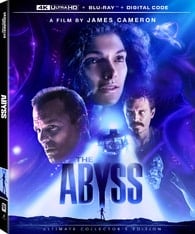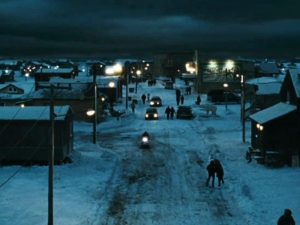There are actually nine Troys. Each one is built on the ruins of the last. Homer’s Troy, which the poet wrote about in The Iliad and The Odyssey, is likely Troy VI, trapped under the ruins of other cities.
Watching Absent Now the Dead, an avant-garde travelogue from Hamilton Sterling, now streaming via Laemmle Cinemas, I thought about the long-dead soldiers of the Trojan War and how deep their corpses must be buried. The hero of Sterling’s film is Thersites, a soldier of King Agamemnon’s who fought at Troy and speaks to us from the afterlife. Thersites (voiced with grumbly portent by Kieran Bew) embarks on a hauntological quest to a “council of tyrants,” three long-dead rulers whose mistakes and shortcomings, Thersites thinks, have poisoned the world for centuries after they were gone.
The Wheel Of Time
For the most part, Absent Now the Dead is a meditative film-poem narrated by Thersites as the spirit meanders through Hellenistic ruins and overgrown temples. He gives us a personal TED Talk on the history of vice, deception, and war, of which many lessons seem pointed at our current epoch — “I followed a monster king for money,” he tells us, “as many have before and since.” Later, Thersites augurs, “Truth dies in doubt,” which is basically the Washington Post’s slogan. “Those who lounge on gold latrines call murder fair,” he says, and I thought of the unblemished, rich interiors of Trump Tower and of a certain Maurizio Cattelan sculpture called America.
Sterling, who also wrote, shot, and edited the film, only directed one other feature, 1997’s Gulf War–focused Faith of Our Fathers. Sterling is a sound editor by trade, having worked on everything from Men In Black to Fury, from Magnolia to The Tree of Life, and he mixes and designs on Absent Now the Dead as well. The film’s soundscape maintains that spiritual temporality Terrence Malick’s work usually excels at, interweaving Thersites’ narration with battles, screams, and Greek choruses. We hear the Trojan War with complete clarity, though we never see it.

In the cinematography, the film keeps one foot in the present and the other 3,500 years in the past. Besides the veiled references to our current state of affairs and its very thrash-metal-vibes title, Absent Now the Dead has a timeless quality. Every image is either black and white or heavily desaturated. Sterling’s primary subjects are Greek monuments, with the odd cutaway to snakes, goats, horses, lions, or a group of turtles swimming around submerged ruins. Though this was likely filmed pre-COVID, it’s hard to tell, as Sterling deliberately never shows tourists, except great distances, when they’re just bodies moving among the columns. To Thersites, the ruins appear like ghost towns.
There’s no shortage of beautiful images here, like the mist pouring over a fire-blackened, barren forest, or a visual motif of a long, black tunnel with daybreak on the other side — drenched in black and white, it felt like an allusion to Michael Haneke’s The White Ribbon. (Sterling‘s camera only fails him for the pans; despite the normally sharp 4K, there’s an unfortunate jello effect to these shots.) The form and content of Absent Now the Dead, though it’s set halfway across the world, reminds me of Werner Herzog’s documentary Wheel of Time and how that film marries impossibly huge landscapes with the fathomlessness of Buddhist philosophy. Just as the Kalachakra, the concept of time as cyclical and all human beings as inherently the same, informs Buddhist thought, so too does the cycle of human nature and cruelty inform Thersites. We keep making the same mistakes, Sterling’s film insists, so part of Thersites’ quest to the council is to show the generals like naked emperors, so all the glory is sucked away and we can break the cycle by showing them for the squabbling, self-centered children they are.
Frankly, I missed the film’s plot entirely upon my initial viewing, strung along solely by the images and what few fragments of Thersites’ speech clicked. The dialogue is overwhelmingly difficult to parse — an average line is “In time, Dread Poseidon will raise the seas, Aeolus will blow and lose the embracing veil of Gaia, our mother, and Erebus, remote among the stars, will remain indifferent to our fate” — so good luck following any of it.
Three Generals Walk Into An Amphitheater
Occasionally, Absent Now the Dead will pivot into fresh territory, brandishing its grandiloquence to denounce organized religion — “Ah, priests… they step dainty yet shit just the same” — or to recount famous myths, such as the tragic undoing of Agamemnon. Yet Agamemnon, I thought, was ax-murdered by his wife in the bathtub, a net thrown over him before he’s hacked into a dozen pieces. Thersites opts for Homer’s more poetic version of the story, wherein Agamemnon returns from Troy and is stabbed by his wife in the feasting hall. In a more anachronistic scene, Thersites picks up a soldier’s jawbone from a stream and muses about its owner and its life, a riff on Hamlet’s Yorick.

Finally, Thersites reaches the council of tyrants. Agamemnon, Odysseus, and Antony (of Antony and Cleopatra fame) sit in an amphitheater surrounded by the ghosts of their followers. Like Thersites, they’re all invisible, just voices on the wind, but their actors (Lloyd Sherr, John Hopkins, and Charlie Hewson, respectively) make the scene compelling, with their brash ignorance and bawdy shouts. “Cleopatra and I visited here once,” Antony muses, sounding a bit drunk. “There were… less weeds.”
At only four minutes, the council scene is the film’s highlight, yet I still felt strangely detached from Absent Now the Dead. I’d say it’s not for me, though I studied English in college and love Greek mythology, so if it isn’t for me, then who is the film for? Classics majors? The dense prose makes it difficult to recommend as a film poem or as a piece of ancient Greek fanfiction — one thinks of A Ghost Story, which centers the same conceit (following a ghost around his old haunts) with a tenth of the dialogue and zero narration, yet is a hundred times more compelling. Maybe Sterling’s script doesn’t comment on modern Greece enough. Seeing ruin after ruin — all of these once-proud buildings built by slaves, centuries of suffering now lying broken, mere pillars without a roof — imbues one with animus toward ancient Greek society that Thersites never entertains.
Conclusion: The Pillar To Nothing
In the film’s final five minutes, Sterling jumps to the present day, sans black and white, to show us modern-day Greek coastlines and fishing trawlers. But what would Thersites think of the Çanakkale Province in Turkey, where Troy’s archeological site lies, or of modern Corinthia, which we only see from a distance, with its cars, cafés, and patisseries? I’m sure The Trip to Greece is a better travelogue, but Sterling’s commitment to Thersites’ 8th-century perspective and aureate rhetoric and diction limits Absent Now the Dead’s potential to transcend its subject matter.
Sterling’s finale makes the metaphor overt, transplanting us to modern-day America, with its capital buildings’ Greek-inspired architecture, intercutting our structures with those of ancient Greece. Placed beside Hellenistic ruins, the Washington Monument seems like one big pillar to nothing. Despite the obviousness of the allegory, which Thersites has been cryptically hinting at for 55 minutes, Sterling doesn’t commit wholly to the idea. Are we meant to view a certain president in the vein of Thersites’ Greek general? Is Sterling warning us that one day, our civilization will be reduced to ruin, with seven more built on its remains? Absent Now the Dead doesn’t have time to explore such themes. But its thesis is clear, spoken aloud at one point by Thersites: “All tyrants lie, all tyrants die.” That’s as warm a consolation as any, even from a soldier who’s 3,500 years in the dirt.
What do you think of Absent Now the Dead, or what’s your favorite film set in Greece? Let us know in the comments below.
Absent Now the Dead is now showing virtually via Laemmle Cinemas.
Watch Absent Now the Dead
Does content like this matter to you?
Become a Member and support film journalism. Unlock access to all of Film Inquiry`s great articles. Join a community of like-minded readers who are passionate about cinema – get access to our private members Network, give back to independent filmmakers, and more.
Join now!



